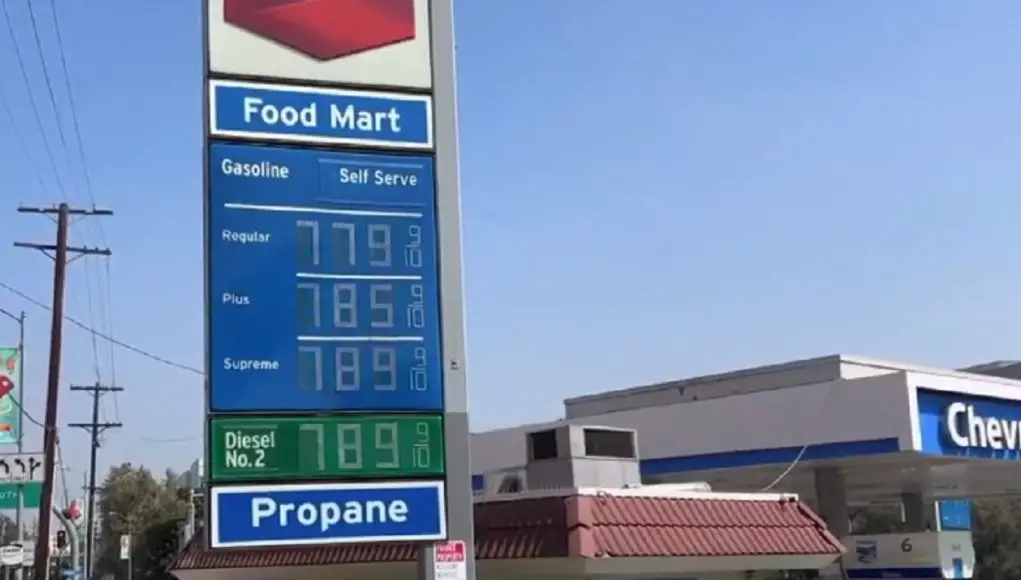A good chunk of why California gas is so expensive is what California lawmakers passed in 1992.
According to AAA Gas Prices, as of Sept. 29, the average price for a gallon of gas in California is $6.07 compared to the $3.82 national average.
Embed from Getty ImagesSo, why are Californians paying an extra $2.25 compared to the rest of the nation?
And, why do California gas prices sometimes spike when the national average is decreasing?
Thankfully, L.A. In A Minute creator Evan Lovett broke it down for us in an easy-to-understand video with a lot of the same data I’ve come across too trying to answer the same questions.
Here’s Lovett’s video below.
First, Lovett explains that, while California has some of the highest gas taxes in the nation, comparatively other states like Illinois and Pennsylvania have just as high State gas taxes.
According to Tax Foundation.org, these are the top 3 states with the highest total gas taxes not including carbon fees.
- California – 77.9 cents per gallon
- Illinois 66.59 cents per gallon
- Pennsylvania 62.28 cents per gallon
And, when you add in additional taxes like the Low Carbon Fuel Standard, and Cap and Trade, according to the California Energy Commission, that 77.9 cents per gallon rises to $1.30 per gallon.
According to government sources, the first $1.30 that California consumers pay at the pump goes toward taxes, fees and government climate programs. And that figure has been steadily rising. 1/3 pic.twitter.com/rKjfhfskq9
— WSPA (@OfficialWSPA) March 16, 2022
That still doesn’t explain it all.
California Reformulated Gasoline
Lovett points out that California accounts for 10% of all cars in the United States.
According to Statista, in 2021 there were 14.3 million cars registered in California, literally almost twice that of both number 2 states Florida and Texas.
As car registrations are correlated with population, those rankings have stayed fairly the same for several decades.
Whatever your stance is on tailpipe emissions, there’s no denying that all those cars produces a lot of smog.
Being progressive as California is, to combat tailpipe emissions, in 1992 the California Air Resource Board implemented the first phase of California Reformulated Gasoline requirements aimed at reducing emissions from motor vehicles.
Yes, California has its own special blend and is the cleanest burning gas of all the 50 states.
But, as such, California reformulated gas can only be produced locally in California-only refineries.
Embed from Getty ImagesThe problem is California refineries continue to close, further stressing those that are open even further as they make up for the added demand.
According to the EIA, in 1984 California had 43 refineries.
Today, California only has 14 refineries.
Another post from the EIA puts it a little more clearly,
“California refineries need to run at near full capacity to meet the state’s gasoline demand. If more than one of its refineries experiences operating problems at the same time, California’s gasoline prices can increase substantially.”
California has seen a 9.2% drop in refinery capacity since 2019 and a 25.2% drop in capacity since 1983, not that you'll hear about that, but refinery problems aren't going away as capacity shrinks.
— Patrick De Haan ⛽️???? (@GasBuddyGuy) September 26, 2023
California’s moves to accelerate to 100% new zero-emission vehicle sales by 2035
Last year, California through CARB passed regulations that essentially bans gas car sales by 2035.
Note, you can still drive a gas car in California, you just can’t buy one.
“What that does is disincentive local producers, refineries, and oil companies to help solve the oil pricing conundrum, and we’re left with oil prices like this (points to gas prices showing 7.83,7.85,7.87, and 8.79 for gas from Regular to Premium and diesel respectively.)”
In other words, this sends a clear message to big oil in California that your days are numbered.
A perfect storm of high prices for a barrel, the switchover to Winter Blend, and ongoing refinery issues since Hurricane Hilary.
Lovett also explains that while California extracts its own crude oil, they still import the majority of its crude oil from overseas (like every other state btw.)
At the end of the day, on any other day, the biggest source of rate increases in the price per gallon in California can be traced back to the price for a barrel of crude oil.
However, as of late, there’s been a perfect storm of conditions (that will only get worse as time goes on) that’s pushed California gas to record levels.
Remember Hurricane Hilary?
Embed from Getty ImagesAlthough weeks ago, that storm has hampered some routine refinery maintenance that refineries are now just catching up to.
Also, in preparation for the Fall switch over to a winter blend of gas, refineries systemically shut down before the change over.
As each refinery shuts down and ramps up, and so on and so forth, you end up with a localized refinery shortage, too.
In conclusion, when you combine the price for crude being the highest since the mid-2010s, the highest taxed gas in the country, only being able to use refined gas by California refineries, and reduced refinery capacity (even smaller supply), you’re left with the most expensive gas in the country and in California history.




